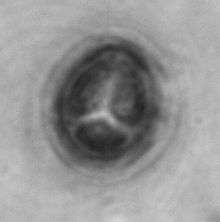Myxobolidae
Myxobolidae is a family of myxosporean parasites which typically infect freshwater fishes, and includes the economically significant species, Myxobolus cerebralis. They have been shown to have a complex life cycle, involving an alternate stage in an invertebrate, typically an annelid or polychaete worm.
| Myxobolidae | |
|---|---|
 | |
| Myxobolus spinacurvatura, a species of Myxobolidae (Myxobolus) | |
| Scientific classification | |
| Kingdom: | Animalia |
| Phylum: | Cnidaria |
| Class: | Myxosporea |
| Order: | Bivalvulida |
| Suborder: | Platysporina Kudo, 1919[1] |
| Family: | Myxobolidae Thélohan, 1892[2] |
Morphology
Myxosporean spores of genera belonging to the Myxobolidae are flattened parallel to the sutural line. They typically contain two polar capsules, and have a central vacuole in which they store β-glycogen. In some genera, the spore walls are drawn out into long processes which are thought to slow sinking through the water column.
Actinosporean stages which have been linked to members of the Myxobolidae have a single central "style" and three processes or “tails”, around 200 micrometers long, projecting from this. A sporoplasm packet at the end of the style contains 64 germ cells surrounded by a cellular envelope. There are also three polar capsules, each of which contains a coiled polar filament.
Genera
- Dicauda Hoffman & Walker, 1978[3]
- Hennegoides Lom, Tonguthai & Dyková, 1991[4]
- Henneguya Thélohan, 1892[2]
- Myxobolus Bütschli, 1882[5]
- Thelohanellus Kudo, 1933[6]
- Trigonosporus Hoshina, 1952[7]
- Unicauda Davis, 1944[8]
References
- Kudo, R. (1919). Studies on Myxosporidia. A synopsis of genera and species of Myxosporidia. Illinois Biological Monographs, 5.
- Thélohan, P. (1892). Observation sur les myxosporidies et éssai de classification de ces organismes. Bulletin de la Société Philomatique de Paris, 4, 165–178.
- Hoffman, G. & Walker, R. (1978). A new myxosporidan, Dicauda atherinodi n. g., n. sp. of the minnow, Notropis atherinoides Rafinesque. Journal of Fish Diseases, 1(4), 343–349.
- Lom, J., Tonguthai, K. & Dyková, I. (1991). Hennegoides longitudinalis n. gen. n. sp., a myxosporean parasite of Osphronemus gourami from Thailand. Diseases of Aquatic Organisms, 11, 143–145.
- Bütschli, O. (1882). Myxosporidia. In Bütschli, O. (Ed.), Dʳ· H. G. Bronn's Klassen und Ordnungen des Thier-Reichs, wissenschaftlich dargestellt in Wort und Bild. Erster Band. Protozoa. Leipzig: C. F. Winter'sche Verlagshandlung.
- Kudo, R. R. (1933). A taxonomic consideration of Myxosporidia. Transactions of the American Microscopical Society, 52, 195–216.
- Hoshina, T. (1952). Notes on some myxosporidian parasites on fishes of Japan. Journal of the Tokyo University of Fisheries, 39(1), 69–89.
- Davis, H. S. (1944). A revision of the genus Henneguya (Myxosporidia) with descriptions of two new species. Transactions of the American Microscopical Society, 63(4), 311–320.